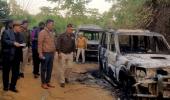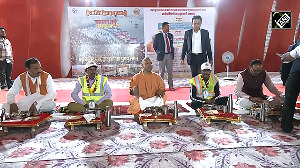The Supreme Court found enough grounds to order a CBI probe into 1,528 extra-judicial killings in Manipur between 2000 and 2012.
Jyoti Punwani reports.

- 'Reliable intelligence', it's being said, led to the latest massacre in Nagaland. Home Minister Amit Shah said the six miners, who were suspected to be militants, 'didn't stop' when ordered to, hence the shooting.
One of the two surviving miners says they were not asked to stop, they were directly shot at.
- 'Reliable intelligence', said the Assam Rifles led them to take away Thangjam Manorama from her home in Imphal late one night in 2004. The 32 year old who supported her family by stitching clothes, was an insurgent, they said. She 'escaped', so they shot her.
Manorama's body was found with hands tied behind her back and 16 bullet wounds; and injuries on her thighs and vagina, which had been shot through. The Justice C Upendra Singh commission of inquiry found the Assam Rifles story false, and described Manorama's killing as 'one of the worst crimes in a civilised society governed by the rule of law'.
But no one was punished, though a nude protest by elderly women in front of the Assam Rifles headquarters in Imphal made front page news across the country. The women held a banner across their bodies saying 'Indian Army, take our flesh'.
When Manorama was killed, Irom Sharmila had already been on fast for four years against the AFSPA, the law which prevents armed forces from being punished for actions they claim were done 'in good faith'. AFSPA was introduced in the North East in 1958, to allow the army to tackle the various extremist/secessionist movements in the region.
Sharmila decided to go on a fast after the November 2000 Malom massacre by the Assam Rifles, in which 10 civilians waiting near a bus stop were shot dead, including a 62-year-old woman and a National Bravery Award winner. The jawans fired indiscriminately after a bomb was lobbed at their vehicle.
Sharmila's fast lasted 16 years and drew the world's attention.
But AFSPA is still very much there in Manipur, as it is in Assam, Nagaland, Mizoram and Arunachal Pradesh. It is also there in Kashmir.

***
While bringing out the human rights bulletin Adhikar Raksha in the 1980s, one read countless accounts of atrocities by the police and security forces on innocent people. One has stayed in mind: The rape of four girls on the pulpit of the Baptist Church in village Yankeli, Nagaland, by men of the First Maratha Regiment (Eighth Mountain Division) in 1971. The girls were aged 17, 15, 12 and 11.
What 'reliable intelligence could have led to that?
The church was abandoned after that incident, it stands in ruins today, a testimony to the way AFSPA has worked in the North East for over half a century.
This outrage was not an exception. In 1987, took place the Oinam tragedy.
The incident took place in Senapati district of Manipur, but the victims were the Nagas who lived there. In retaliation to an attack on them by Naga extremists who took away their arms and ammunition after killing nine jawans and seriously injuring three others, the Assam Rifles launched Operation Bluebird to recover the arms.
For three months, 30 villages were declared a 'Disturbed Area' under the AFSPA and turned into a concentration camp. According to a petition filed by the Naga People's Movement for Human Rights (NPMHR) in the Guwahati high court, 27 persons, including village elders and babies, died due to torture or starvation; three women were raped.
Two pregnant women, detained along with other villagers, were forced to give birth in public view; one lost her baby. 300 teachers, pastors, headmen, famers were tortured; villagers were made to carry rations for the Assam Rifles over hilly roads for 15-20 kms.
Over 100 houses were destroyed. Six schools were shut or occupied. Ten churches were used as detention and sometimes, torture chambers.
Elected representatives and journalists who tried to visit the area were detained; some were released only after habeas corpus petitions were filed. The CM, the chief secretary and the head of police weren't allowed to go beyond the helipad.
In a memorandum to Buta Singh, then the Congress home minister of India, the then Congress CM of Manipur Rishang Keishing wrote: 'The Assam Rifles have virtually gone berserk... The civil law has ceased to operate in Senapati district...the Assam Rifles are running a parallel government in the area.'
As per the high court's directions, witnesses travelled from their villages to testify before the sessions court at Imphal. Final arguments were made by the well known lawyer Nandita Haksar for the NPMHR in March 1992.
However, the judgment remained pending and in 2019, the case was disposed of because the records could not be located.
Oinam is commemorated every year as Onae Reh Dah or the Great Battle of Oinam till today, with scenes of torture being enacted.
But even Oinam didn't spell the end of the torment for the Nagas.

Leiong was among 14 civilians killed by security forces. Photograph: PTI Photo
- In December 1994 in Mokokchung, five civilians were burnt alive when their homes were set on fire by men of the Maratha Light Infantry in retaliation to an attack on them by insurgents in which one jawan and one officer were killed. Three other civilians were killed outside their homes and four women raped.
- The next month, an Assam Rifles unit was fired on by militants in Akhulato. Unable to find the militants, the jawans asked villagers to come out of their homes and then burnt the homes, suspecting that villagers had given shelter to the militants.
One couple refused the Assam Rifles' order to put their children down and come out of the house. A jawan, Subedar Khelaram, fired at the woman. She died and the hand of her three-month-old baby was blown off. - Two months later, in March 1995, a tyre burst in Kohima as a convoy of Rashtriya Rifles was passing from Manipur to Nagaland. Thinking they were being attacked, the jawans started shooting indiscriminately, killing seven civilians.
The Justice D M Sen Commission set up to investigate these three incidents, came out with a report indicting the armed forces for 'completely indefensible acts of criminality.' But before the Nagaland government could act on his report, the Supreme Court granted a stay on its implementation, at the request of the defence ministry.
In a rare move, Subedar Khelaram was court martialled, but the punishment he was awarded was a mere 45 days' rigorous punishment, 8 years' loss of seniority and 4 years' loss of pension. Four other jawans were also awarded rigorous punishment.

***
It is not Nagaland alone that has seen excesses by the armed forces, nor was Manorama the only innocent to be killed in Manipur. The Supreme Court in 2017 found enough grounds to order a CBI probe into 1,528 extra-judicial killings in Manipur between 2000 and 2012. 39 cases were registered, of which 15 were closed. In the remaining, sanction was not given by the army to prosecute the indicted personnel.
Mizoram experienced AFSPA in 1967, when the state was part of Assam. The Mizo areas were subjected to 'village regrouping', an exercise meant to control the influence of insurgents. Villagers in over 500 villages were ordered to shift without notice to new barricaded 'villages', which they could enter or leave only with an ID card. This forced regrouping led to a steep fall in agricultural production and food shortages, and also gradually, to alcoholism and drug addiction, neither of which had existed earlier.
Assam was declared a Disturbed Area in November 1990, to fight ULFA (the United Liberation Front of Asom). Not just civil liberties organisations, but even The Times of India reported in January 1991 the large number of reports pouring in about killings, torture, rape and harassment by the army. 150 habeas corpus petitions were filed in the Guwahati high court from November to April. The court upheld many of these, awarding compensation to some.

***
For decades, these experiences of the North Eastern states remained unknown in the rest of India. It was only after the Emergency, when human rights organisations became more visible and investigative journalism became the norm, that the mainstream press decided it could publish reports that questioned the army's conduct. By the time Manorama's killing took place in 2004, the excesses allowed by AFSPA were no longer a secret.
The furore over Manorama's murder prompted the then newly elected Manmohan Singh government at the Centre to set up the Justice Jeevan Reddy Committee. Its members travelled throughout the North East listening to citizens, and army and government representatives. Its report in 2005 recommended a repeal of the Act, but, interestingly, not a complete withdrawal of the army from the North East.
The Act, it found, had 'become a symbol of oppression, an object of hate and an instrument of discrimination and high-handedness. It is highly desirable and advisable to repeal this Act altogether, without, of course, losing sight of the overwhelming desire of an overwhelming majority of the region that the Army should remain (though the Act should go).'
However, the Committee's other recommendations are troubling. These include incorporating some of the AFSPA's clauses into the UAPA; and setting up grievance cells made up entirely of security forces. These recommendations even dilute the Supreme Court orders during the Manipur fake encounter petition, which directed that the armed forces must always act in consultation with the local police.
The UPA took no decision on the Jeevan Reddy committee's recommendation; the Narendra Modi government has ruled out any repeal of AFSPA.
Will the coming elections in Manipur change this view? And if it does, will we now have a far worse UAPA?
Feature Presentation: Aslam Hunani/Rediff.com











 © 2025
© 2025